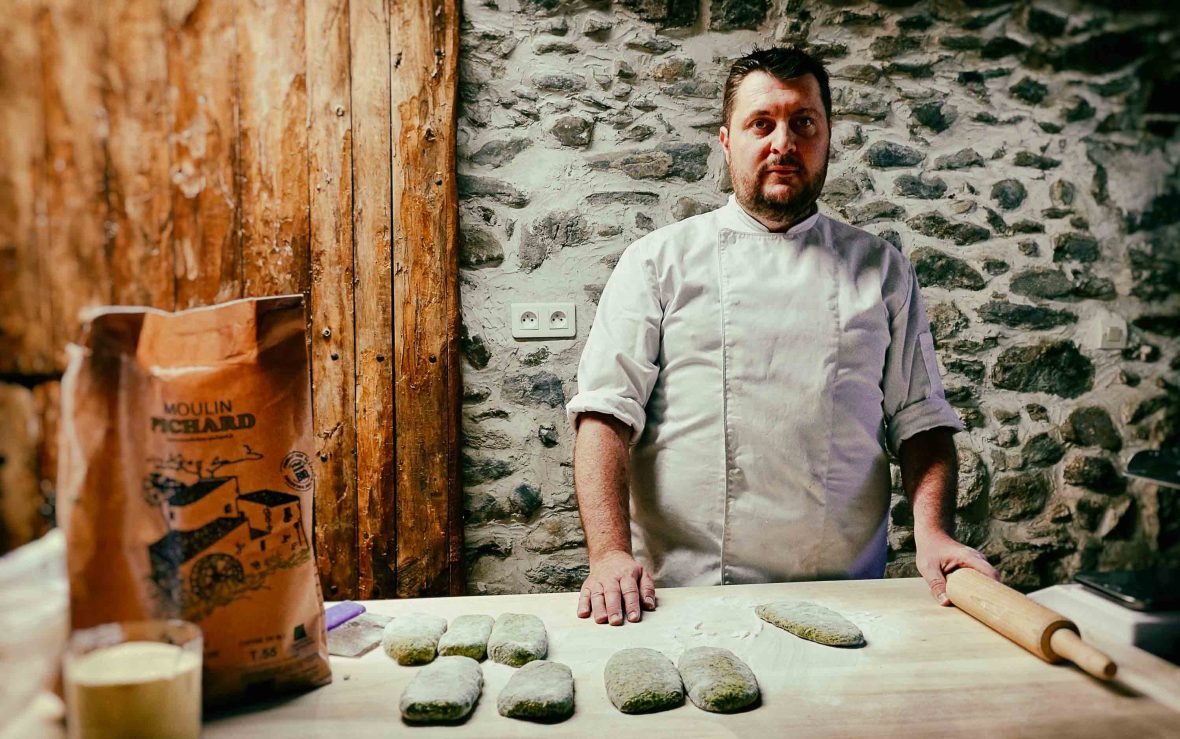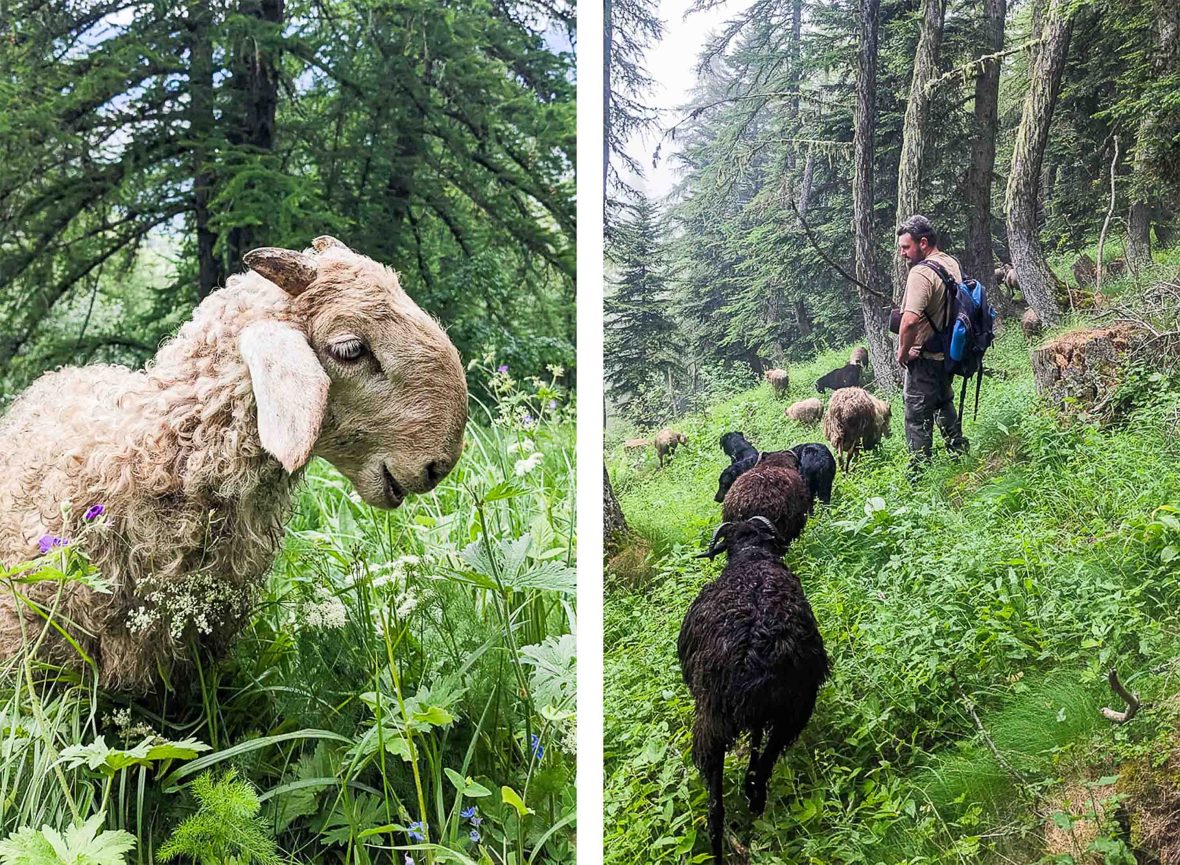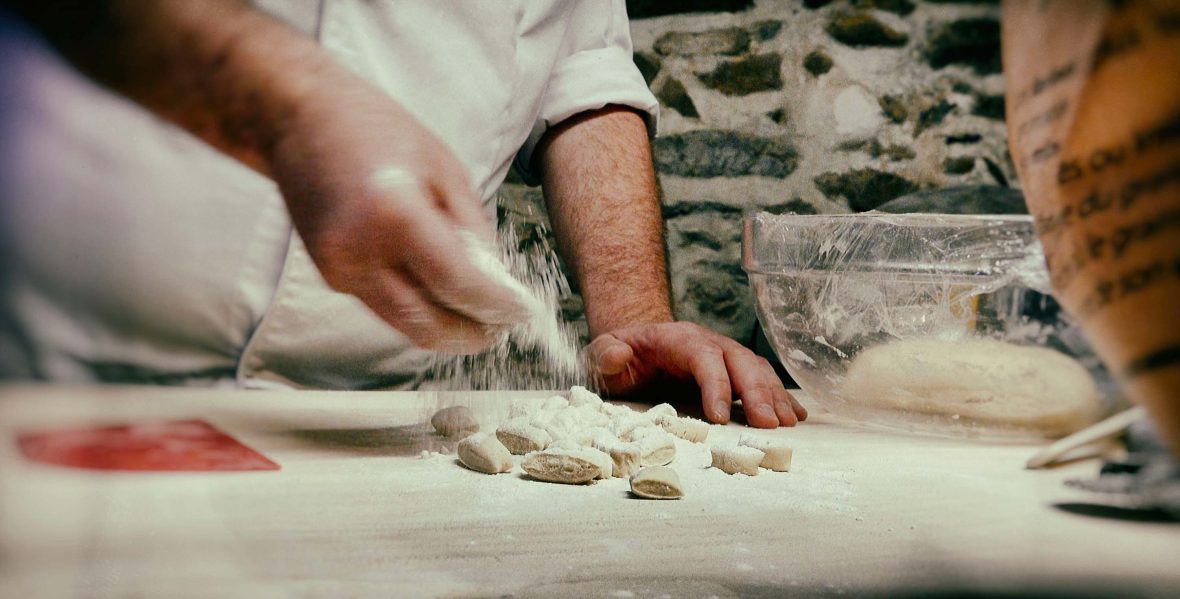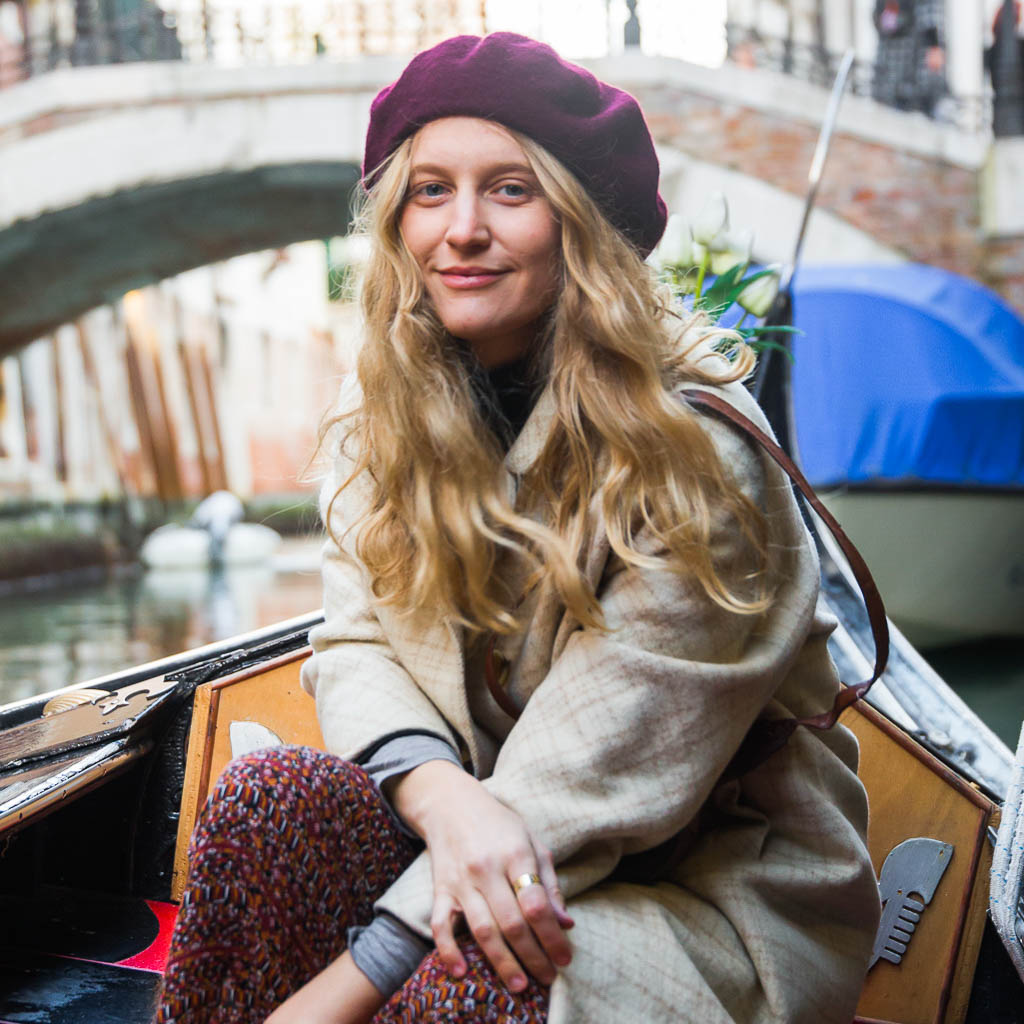
Forget the colorful Mediterranean diet, ‘La Cuisine Blanche’ embraces the ‘white food’—think flour, legumes and dairy—of the French-Italian border.


Forget the colorful Mediterranean diet, ‘La Cuisine Blanche’ embraces the ‘white food’—think flour, legumes and dairy—of the French-Italian border.
I’m sitting in the La Cucina Bianca restaurant in the small town of La Brigue in Alpes-Maritimes, southeastern France, tucking into my Tantifuluza starter. Its name comes from the local dialect word for potato (tantifula) and inside the light pastry of the circular pie is a hearty mix of potato, sautéed leeks, squash and grated sheep’s cheese.
This pie, explains Patrick Teisseire, owner and chef, is emblematic of the local Cuisine Blanche (‘white food’), and perfectly suited to the nomadic shepherds who roam the area; it’s easily transportable and can be eaten warm or cold.
Next comes a plate of osso bucco à la Paysanne, a dish traditionally reserved for holy days and holidays, when the shepherds return from months in the high-altitude forests where they’ve been protecting their flocks from predatory wolves. Patrick cooks the aromatic lamb shanks over a low heat for hours to soften it, then serves it with shell-shaped Sügeli pasta cooked with the meaty cooking juices. Sügeli is La Cuisine Blanche’s most celebrated dish; it’s been inscribed on France’s ‘patrimoine culturel immatériel’ (intangible cultural heritage) list since 2008.

This is filling food that wouldn’t be out of place on a ski mountain or in a hiker’s refuge; hearty, rich, meaty, delicious and, well, being honest, very beige. Just as the ancient and mountainous landscape of this border region between Italy and France, with its villages that cling to the rock face, feels a world away from the primary colors of the coast, so too does the food show a different colour palette. No bright red and yellow tomatoes, no crisp green leaves; in fact, the only hint of the area’s proximity to Provence is a sprig of rosemary sticking out like a flag from my pile of pasta.
Teisseire, who has spent the last few years championing this ancient way of cooking, set up La Cucina Bianca after having run a pizza restaurant here for years. “It was when I tried to understand Brigasque cuisine in order to give an identity to my restaurant that I was able to define exactly what La Cuisine Blanche is,” he tells me.
“I can’t leave them [flock] alone, day or night, so I sleep on site in the mountains. I use spring water and take food provisions with me. It requires careful planning because the return trips are long and expensive.”
- Barthélémy Lantéri, shepherd from La Brigue
La Cuisine Blanche’s main ingredients are milk, flour and white vegetables including potatoes, leeks, cabbage and garlic as well as pulses and herbs. It’s a good example of slow food, as ingredients are plentiful and local. In fact, the Slow Food movement, which champions local food and traditional cooking, was founded in Italy by Carlo Petrini in 1986.
Teisseire is keen to emphasise its longevity in this cross-border region. “It’s the cuisine of the shepherds who have roamed the slopes of Piedmont, Liguria and the Maritime Alps for centuries with their flocks of sheep,” he says, “but it can also be found in other places where nomads move with their herds and adapt to the territories in which they find themselves—for example, in Puglia in southern Italy, where they make orecchiette which are very similar to Sügeli from the Brigasque area.”
To really understand this style of cooking, you need to understand the region from which it originates. The frontier region lies just 50 kilometers north of the Mediterranean coast and its character comes from a mishmash of French and Italian influences; there’s an abundance of peeling terracotta stucco and trompe d’oeil (optical illusion art) on the buildings’ façades as well as many Baroque churches, and a fascinating linguistic fluidity.
People speak Italian or French or both, and each village has its own dialect that has existed for centuries. In 1947, the border was changed after the Paris Peace Treaties, and France acquired territory that had previously been Nazi-occupied Italy. People in towns like La Brigue were suddenly French, separated from Italian family members in neighboring villages and forced to speak a different language at school and in work.
While towns like Sospel, La Brigue and Tende have developed thanks to their proximity to rivers and roads, the region is mostly impassable mountainous terrain, criss-crossed by nomadic shepherds and their flocks.
La Cuisine Blanche is inextricably linked to a nomadic type of shepherding called transhumance. Based on the availability of large common spaces, it involves shepherds moving their flocks between altitudes depending on the season. They spend months on the mountain and live on what the local landscape has to offer, as I’d soon learn from Barthélémy Lantéri, a shepherd from La Brigue.
Lantéri looks after a flock of nearly 100 Brigasque sheep. “In the valley floors in summertime, it is too hot and the vegetation gets damaged in the sun,” he tells me. “In the autumn, when the cold weather sets in on higher ground, we go back down to take advantage of the lower areas where the vegetation has been renewed.”
“Think of it as experiencing several springs in a year,” he adds. “Because we follow the growth of grass and vegetation at altitude, as the season progresses, we can keep offering renewed food to the animals which is better for their health and their production of fat and milk.”
“La Cucina Bianca is an age-old diet of shepherds, farmers and woodsmen that unites France, Piedmont and the Ligurian mountains both through the language and the lifestyle. It’s about parental affection, care and a sense of belonging.”
- Emidia Lantrua, Strada della Cucina Bianca—Civiltà delle Malghe
Lantéri needs to keep a constant eye on his flock, due to the very real danger of wolves. “I can’t leave them alone, day or night, so I sleep on site in the mountains,” he says. “I use spring water and take food provisions with me. It requires careful planning because the return trips are long and expensive.”
His provisions include pasta, fresh curd slices, herbs and olive oil, as well as ricotta-stuffed vegetables, honey, nuts and sugar. Sometimes, he says, he even takes the sub-standard offcuts of tomme (Alpine) cheese that can’t be sold, to pep up his Sugeli pasta.

It’s easy to see why La Cuisine Blanche works for shepherds like Lantéri, but I’m interested to know why it’s also popular in the valley kitchens. Lantéri explains that in La Brigue, transhumance is a way of life that resonates enormously with residents whether they are shepherd themselves or not.
“A century ago, there was one shepherd per family, and although that’s not the case now, it still forms the identity of the whole village,” says Lantéri. “It is a collective work which is only possible through the solidarity of the people who provide land for the flocks. Very often, people are happy to do this in memory of their own family who have gone before them.”
Over the border into Italy, I meet more ‘White Cuisine’ advocates, including Emidia Lantrua, president of the Strada della Cucina Bianca—Civiltà delle Malghe (Road of the White Cuisine—Civilization of the Sheepfolds)—an association that was created nearly 25 years ago to promote this way of cooking.
She agrees with Lantéri about the cuisine’s cultural importance: “La Cucina Bianca is an age-old diet of shepherds, farmers and woodsmen that unites France, Piedmont and the Ligurian mountains both through the language and the lifestyle,” Lantrua tells me. “It’s about parental affection, care and a sense of belonging.”

Elisa Sciandini, owner of Agriturismo Cioi Longhi in Montegrosso Pian Latte in Italy’s Liguria region, believes that its modern relevance speaks to the fact that many people are looking for simple dishes without preservatives. The dishes she makes in her agriturismo (farmstay) are made with local products that would always have been available to shepherds. “Most of the ingredients I use are produced right here on site,” she says, “including the vegetables and flour, as well as the cheese and milk from our goats.”
Typical dishes here include raviore of Montegrosso Pian Latte, a filled pasta of wild herbs, olive oil and cheese. “I also make torta di patate,” she says, “which is a savory cake made with potatoes and pepper, and streppa e caccia la’, a simple dough that I make with just flour and water with a brussu (fermented ricotta) sauce.”
Back in La Brigue, Teisseire tells me that La Cuisine Blanche is the epitome of Slow Food. “We want to be part of the fight against climate change by consuming according to the seasons and our territory,” he tells me, “and we know it is healthier for us to eat dishes made from seasonal products that have been prepared in an artisanal and non-industrial way.”
I’m reminded of what Lantéri spoke about, that not only is La Cuisine Blanche tasty, it’s also sustainable: “It’s an economical solution that promotes areas that are difficult to access or otherwise not very useful, and it’s ecological,” he’d said. “With both nomadic shepherding and La Cuisine Blanche, we are following a resource offered by the sun, the rain and the earth.”
****
Adventure.com strives to be a low-emissions travel publication. We are powered by, but editorially independent of, Intrepid Travel, the world’s largest travel B Corp, who help ensure Adventure.com maintains high standards of sustainability in our work and activities. You can visit our sustainability page or read our Contributor Impact Guidelines for more information.






Can't find what you're looking for? Try using these tags: